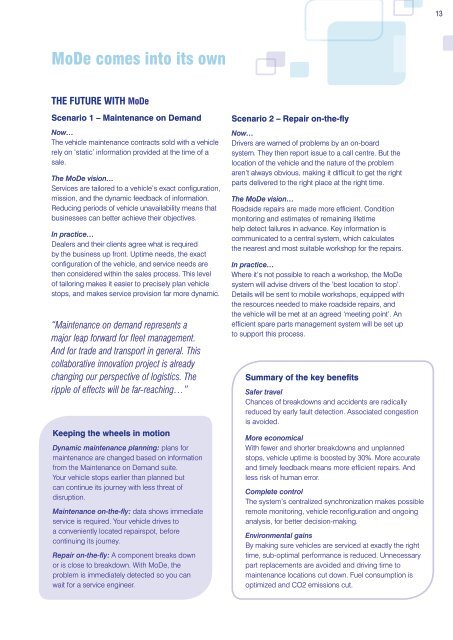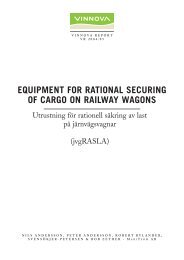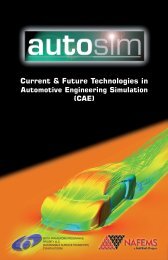FUTURE-PROOFING the automotive industry - FP7-Mode
FUTURE-PROOFING the automotive industry - FP7-Mode
FUTURE-PROOFING the automotive industry - FP7-Mode
You also want an ePaper? Increase the reach of your titles
YUMPU automatically turns print PDFs into web optimized ePapers that Google loves.
13<br />
MoDe comes into its own<br />
THE <strong>FUTURE</strong> WITH MoDe<br />
Scenario 1 – Maintenance on Demand<br />
Now…<br />
The vehicle maintenance contracts sold with a vehicle<br />
rely on ‘static’ information provided at <strong>the</strong> time of a<br />
sale.<br />
The MoDe vision…<br />
Services are tailored to a vehicle’s exact configuration,<br />
mission, and <strong>the</strong> dynamic feedback of information.<br />
Reducing periods of vehicle unavailability means that<br />
businesses can better achieve <strong>the</strong>ir objectives.<br />
In practice…<br />
Dealers and <strong>the</strong>ir clients agree what is required<br />
by <strong>the</strong> business up front. Uptime needs, <strong>the</strong> exact<br />
configuration of <strong>the</strong> vehicle, and service needs are<br />
<strong>the</strong>n considered within <strong>the</strong> sales process. This level<br />
of tailoring makes it easier to precisely plan vehicle<br />
stops, and makes service provision far more dynamic.<br />
“Maintenance on demand represents a<br />
major leap forward for fleet management.<br />
And for trade and transport in general. This<br />
collaborative innovation project is already<br />
changing our perspective of logistics. The<br />
ripple of effects will be far-reaching…”<br />
Keeping <strong>the</strong> wheels in motion<br />
Dynamic maintenance planning: plans for<br />
maintenance are changed based on information<br />
from <strong>the</strong> Maintenance on Demand suite.<br />
Your vehicle stops earlier than planned but<br />
can continue its journey with less threat of<br />
disruption.<br />
Maintenance on-<strong>the</strong>-fly: data shows immediate<br />
service is required. Your vehicle drives to<br />
a conveniently located repairspot, before<br />
continuing its journey.<br />
Repair on-<strong>the</strong>-fly: A component breaks down<br />
or is close to breakdown. With MoDe, <strong>the</strong><br />
problem is immediately detected so you can<br />
wait for a service engineer.<br />
Scenario 2 – Repair on-<strong>the</strong>-fly<br />
Now…<br />
Drivers are warned of problems by an on-board<br />
system. They <strong>the</strong>n report issue to a call centre. But <strong>the</strong><br />
location of <strong>the</strong> vehicle and <strong>the</strong> nature of <strong>the</strong> problem<br />
aren’t always obvious, making it difficult to get <strong>the</strong> right<br />
parts delivered to <strong>the</strong> right place at <strong>the</strong> right time.<br />
The MoDe vision…<br />
Roadside repairs are made more efficient. Condition<br />
monitoring and estimates of remaining lifetime<br />
help detect failures in advance. Key information is<br />
communicated to a central system, which calculates<br />
<strong>the</strong> nearest and most suitable workshop for <strong>the</strong> repairs.<br />
In practice…<br />
Where it’s not possible to reach a workshop, <strong>the</strong> MoDe<br />
system will advise drivers of <strong>the</strong> ‘best location to stop’.<br />
Details will be sent to mobile workshops, equipped with<br />
<strong>the</strong> resources needed to make roadside repairs, and<br />
<strong>the</strong> vehicle will be met at an agreed ‘meeting point’. An<br />
efficient spare parts management system will be set up<br />
to support this process.<br />
Summary of <strong>the</strong> key benefits<br />
Safer travel<br />
Chances of breakdowns and accidents are radically<br />
reduced by early fault detection. Associated congestion<br />
is avoided.<br />
More economical<br />
With fewer and shorter breakdowns and unplanned<br />
stops, vehicle uptime is boosted by 30%. More accurate<br />
and timely feedback means more efficient repairs. And<br />
less risk of human error.<br />
Complete control<br />
The system’s centralized synchronization makes possible<br />
remote monitoring, vehicle reconfiguration and ongoing<br />
analysis, for better decision-making.<br />
Environmental gains<br />
By making sure vehicles are serviced at exactly <strong>the</strong> right<br />
time, sub-optimal performance is reduced. Unnecessary<br />
part replacements are avoided and driving time to<br />
maintenance locations cut down. Fuel consumption is<br />
optimized and CO2 emissions cut.
















